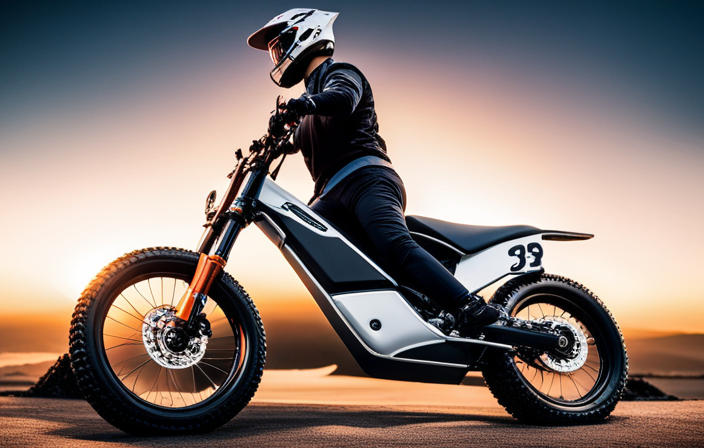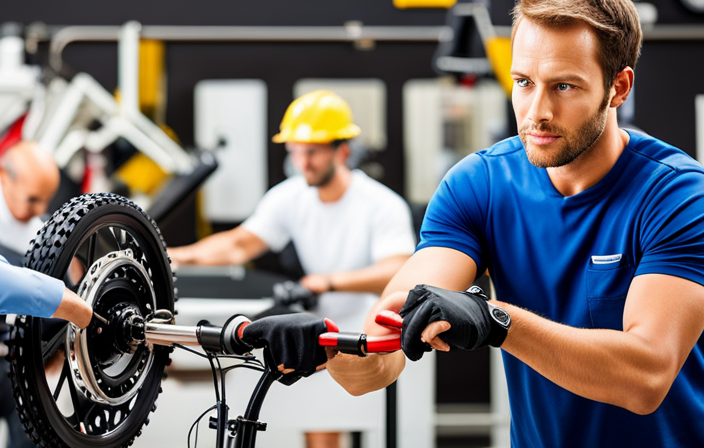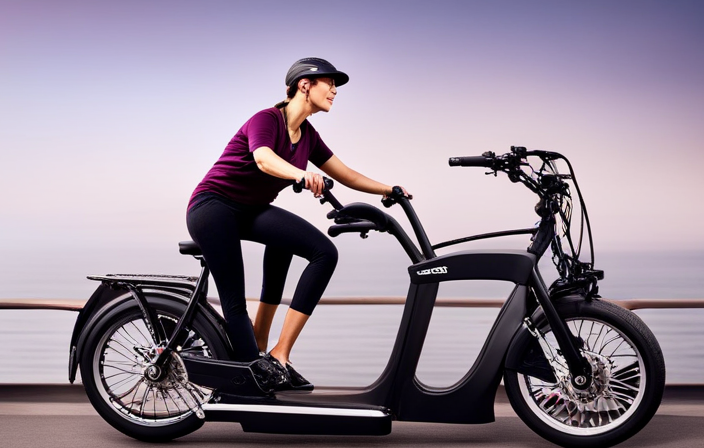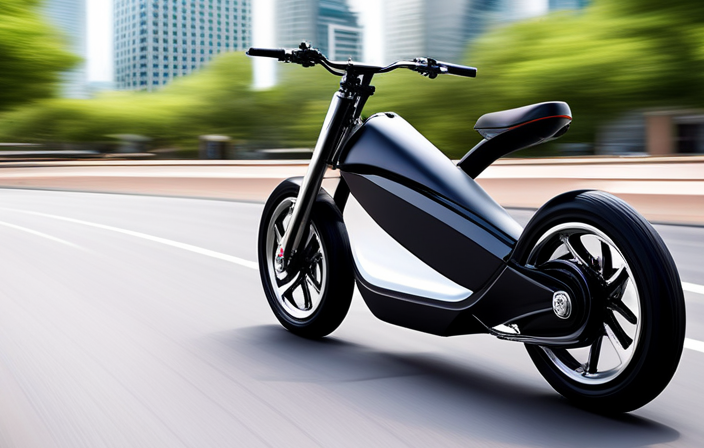Being a passionate fan of dirt bikes, I have always been intrigued by the power and performance of electric dirt bikes. A key factor that plays a significant role in their exceptional performance is the type of battery they are equipped with.
In this article, we’ll delve into the different types of batteries found in electric dirt bikes, such as lithium-ion, nickel-metal hydride, and lead-acid batteries. By understanding the intricacies of these battery systems, you’ll be equipped with the knowledge to make an informed decision when it comes to choosing the right battery for your electric dirt bike.
Key Takeaways
- Lithium-ion batteries are the most popular choice for electric dirt bikes due to their high energy density and longer lifespan.
- Other battery types such as nickel-metal hydride (NiMH), lead-acid, and nickel-cadmium (NiCd) batteries are also considered as alternative options.
- Lithium iron phosphate (LiFePO4) batteries offer advantages in terms of lower cost, lower maintenance, and suitability for off-road riding.
- Sodium-ion batteries, zinc-air batteries, and solid-state batteries are also being explored for their potential in electric dirt bikes, but they have their own advantages and limitations.
Lithium-ion Batteries
You should know that lithium-ion batteries are commonly used in electric dirt bikes. These batteries offer several advantages that make them an ideal choice for powering these vehicles.
One major advantage is their high energy density, which means they can store a large amount of energy in a compact size. This allows for longer riding distances without the need for frequent recharging. Additionally, lithium-ion batteries have a longer lifespan compared to other battery types, which reduces the need for frequent replacements.
However, there are also some disadvantages to consider. Lithium-ion batteries can be expensive compared to other options, and they require careful handling to prevent overheating or damage. Despite these drawbacks, lithium-ion batteries remain a popular choice for electric dirt bikes.
Speaking of alternative options, let’s now explore nickel-metal hydride (NiMH) batteries.
Nickel-metal Hydride (NiMH) Batteries
When considering alternative battery options for electric dirt bikes, one environmentally friendly option to explore is Nickel-metal Hydride (NiMH) batteries. These batteries offer a good energy density, meaning they can store a significant amount of energy for their size and weight.
Additionally, NiMH batteries tend to have a lower cost compared to lithium-ion batteries, making them an attractive choice for those looking for a more affordable power source.
Environmentally friendly option
An environmentally friendly option for the battery in an electric dirt bike is a lithium-ion battery. Lithium-ion batteries have gained popularity in recent years due to their numerous advantages and positive impact on the environment. Here are three reasons why lithium-ion batteries are a great choice for electric dirt bikes:
-
Renewable energy sources: Lithium-ion batteries can be charged using renewable energy sources such as solar or wind power. This means that the energy used to charge the battery comes from clean and sustainable sources, reducing reliance on fossil fuels.
-
Impact on air quality: Electric dirt bikes powered by lithium-ion batteries produce zero emissions during operation. Unlike traditional combustion engines, which release harmful pollutants into the air, lithium-ion battery-powered bikes contribute to improved air quality and reduced pollution.
-
Long lifespan: Lithium-ion batteries have a longer lifespan compared to other battery options. This means less frequent replacement and fewer batteries ending up in landfills, reducing environmental impact.
Transitioning into the subsequent section about ‘good energy density,’ it is important to note that lithium-ion batteries also offer a high energy density, allowing for longer rides and greater overall performance.
Good energy density
With good energy density, lithium-ion batteries provide longer rides and better performance for your electric dirt bike. These batteries offer exceptional energy efficiency, storing a high amount of energy in a compact space. This means that you can experience extended riding sessions without worrying about running out of power.
Additionally, lithium-ion batteries have a long-lasting performance, allowing you to enjoy your electric dirt bike for years to come. Their durability ensures that they can handle the demands of off-road riding and continue to provide reliable power. Moreover, the advanced technology used in lithium-ion batteries maximizes their efficiency, minimizing energy loss during charging and discharging. As a result, you can rely on these batteries to deliver consistent and efficient power for your electric dirt bike.
Transitioning to the next section, while lithium-ion batteries offer these advantages, they also come with a lower cost compared to other battery options.
Lower cost compared to lithium-ion batteries
The lower cost of lithium-ion batteries compared to other options makes them a more affordable choice. When exploring alternative battery options and evaluating the feasibility of alternative battery technologies, cost is a crucial factor to consider. Lithium-ion batteries have gained popularity in various applications, including electric dirt bikes, due to their affordability. Let’s compare the cost of lithium-ion batteries with other battery technologies commonly used in electric vehicles:
| Battery Technology | Cost per kWh |
|---|---|
| Lithium-ion | $150 |
| Nickel Metal Hydride (NiMH) | $250 |
| Lead-Acid | $80 |
As shown in the table, lithium-ion batteries offer the most cost-effective solution for electric dirt bikes. This affordability allows for broader adoption of electric bikes, making them more accessible to a wider range of riders. However, while lithium-ion batteries may be more affordable, it is important to evaluate their performance and suitability for specific applications. Transitioning into the subsequent section, let’s now explore the feasibility of using lead-acid batteries in electric dirt bikes.
Lead-acid Batteries
You should consider using lead-acid batteries for your electric dirt bike. These batteries offer several advantages, including lower maintenance and longer lifespan compared to other battery types.
Lead-acid batteries are known for their robustness and ability to withstand rugged off-road conditions. They require minimal maintenance, making them a reliable choice for your dirt bike. With proper care and regular charging, lead-acid batteries can last for several years, providing you with worry-free riding experiences.
However, if you’re looking for even higher performance and lighter weight, you may want to consider lithium polymer (lipo) batteries. These batteries offer faster recharge times and higher energy density, making them a popular choice among electric dirt bike enthusiasts.
Lithium Polymer (LiPo) Batteries
If you’re after higher performance and lighter weight, consider opting for lithium polymer (LiPo) batteries. These batteries have become increasingly popular in electric dirt bikes due to their impressive power-to-weight ratio.
One key advantage of LiPo batteries is their faster charging time compared to other battery types. With the right charger, you can recharge a LiPo battery in just a fraction of the time it takes for other batteries.
However, it is important to note that extreme temperatures can have a significant impact on the performance of LiPo batteries. High temperatures can cause the battery to degrade more quickly, while low temperatures can reduce its overall capacity. It is crucial to properly store and operate LiPo batteries within the recommended temperature range to ensure optimal performance.
Transitioning into the next section about nickel-cadmium (NiCd) batteries, it’s important to weigh the pros and cons of each battery type before making a decision.
Nickel-cadmium (NiCd) Batteries
When it comes to discussing Nickel-cadmium (NiCd) batteries, there are three key points that need to be highlighted.
Firstly, NiCd batteries have a good cycle life, meaning they can be charged and discharged numerous times before losing their effectiveness.
Secondly, they have a high discharge rate, allowing for quick and efficient power delivery.
However, it is important to note that NiCd batteries are environmentally hazardous due to their cadmium content, which poses risks to both human health and the ecosystem if not properly disposed of.
Good cycle life
The electric dirt bike has a battery with a good cycle life. This means that the battery can go through many charge and discharge cycles before it starts to degrade and lose its capacity. The advantage of a battery with a good cycle life is that it can be used for a longer period of time without needing to be replaced. This is especially important for electric dirt bikes, as they are often used for off-road adventures where a reliable and durable battery is essential. However, there are also some disadvantages to consider. One disadvantage is that batteries with a good cycle life tend to be more expensive compared to batteries with a shorter cycle life. Additionally, these batteries may be heavier, which can affect the overall performance and maneuverability of the dirt bike.
| Advantages | Disadvantages |
|---|---|
| Longer battery lifespan | Higher cost |
| Reliable and durable | Increased weight |
| Potential performance impact |
With a battery that has a good cycle life, the electric dirt bike can provide a longer-lasting and reliable power source for your off-road adventures. However, there is another important factor to consider: the high discharge rate of the battery.
High discharge rate
Having a high discharge rate means the battery can provide a quick and powerful burst of energy for acceleration and high-speed performance. This feature offers several advantages in electric dirt bikes:
-
Enhanced speed: With a high discharge rate, the battery can deliver the necessary energy to achieve faster speeds, giving riders an exhilarating experience.
-
Quick acceleration: Electric dirt bikes equipped with high discharge rate batteries can accelerate rapidly, allowing riders to quickly navigate through various terrains.
-
Improved performance: The ability to deliver a powerful burst of energy ensures that the bike performs optimally, providing riders with a thrilling and responsive riding experience.
-
Increased versatility: High discharge rate batteries enable electric dirt bikes to handle challenging terrains with ease, making them suitable for various off-road adventures.
However, there are also some disadvantages to consider:
-
Reduced overall battery life: The higher the discharge rate, the quicker the battery may deplete, resulting in a shorter overall battery life.
-
Increased heat generation: High discharge rates can cause the battery to generate more heat, which may lead to decreased efficiency and potential damage if not properly managed.
-
Higher cost: Batteries with high discharge rates tend to be more expensive, adding to the overall cost of the electric dirt bike.
-
Limited selection: Not all electric dirt bikes come equipped with high discharge rate batteries, limiting the options available to riders.
It’s important to note that high discharge rate batteries used in electric dirt bikes can be environmentally hazardous due to their cadmium content, which will be discussed in the subsequent section.
Environmentally hazardous due to cadmium content
You should be aware that the high discharge rate batteries used in electric dirt bikes can pose an environmental hazard due to their cadmium content. Cadmium is a toxic heavy metal that can have detrimental effects on both human health and the environment. As a result, it is essential to consider cadmium-free alternatives when choosing batteries for electric dirt bikes.
One way to assess the environmental impact of these batteries is through an environmental impact assessment, which evaluates the potential harm they may cause throughout their lifecycle. By considering cadmium-free alternatives and conducting a thorough environmental impact assessment, we can minimize the negative effects of these batteries on the environment and ensure a more sustainable future.
Transitioning into the subsequent section, let’s explore the benefits of lithium iron phosphate (LiFePO4) batteries.
Lithium Iron Phosphate (LiFePO4) Batteries
When it comes to electric dirt bikes, one option for batteries is lithium iron phosphate (LiFePO4). LiFePO4 batteries have gained popularity due to their numerous advantages over other battery types.
One of the key advantages is their long lifespan, which can be up to 2000 cycles compared to around 500 cycles for other lithium batteries. Additionally, LiFePO4 batteries are more stable and have a lower risk of thermal runaway, making them safer to use. They also have a higher tolerance for extreme temperatures and can perform well in both hot and cold environments.
Another significant advantage is their faster charging time. LiFePO4 batteries can be charged in as little as 2 hours, whereas other lithium batteries may take up to 6 hours to reach full capacity. This makes them a convenient choice for electric dirt bike riders who don’t want to wait around for their battery to charge.
Now, let’s transition to the next section where we will discuss sodium-ion batteries.
Sodium-ion Batteries
Sodium-ion batteries are a promising alternative to lithium batteries due to their potential for high energy density. These batteries have a wide range of applications, including the storage of renewable energy, electric vehicles, and portable electronics. Sodium-ion batteries use sodium ions instead of lithium ions for charge storage, which allows for the use of abundant and low-cost sodium resources.
However, there are some limitations to sodium-ion batteries that need to be addressed. One major limitation is the lower energy density compared to lithium-ion batteries, which affects the overall performance and range of electric vehicles. Additionally, sodium-ion batteries face challenges in terms of cycle life and safety.
Despite these limitations, ongoing research and development efforts aim to overcome these hurdles and unlock the full potential of sodium-ion batteries.
Looking ahead, let’s explore another promising battery technology: zinc-air batteries.
Zinc-air Batteries
After exploring the potential of sodium-ion batteries, let’s delve into another promising option for electric dirt bikes: zinc-air batteries. These batteries utilize a zinc anode and oxygen from the air as the cathode, generating electrical energy through a chemical reaction.
Here are the advantages and limitations of zinc-air batteries:
-
Advantages
- High energy density: Zinc-air batteries can store a large amount of energy, providing longer driving ranges for electric dirt bikes.
- Lightweight: The absence of heavy metals like lithium reduces the weight of the battery, enhancing the bike’s overall performance.
- Cost-effective: Zinc is abundant and inexpensive, making zinc-air batteries a more affordable option compared to other battery technologies.
-
Limitations
- Limited lifespan: The zinc electrode gradually corrodes over time, reducing the battery’s efficiency and lifespan.
- Slow recharge: Recharging a zinc-air battery can be time-consuming due to the need to replenish the zinc anode.
- Environmental impact: The disposal of zinc-air batteries requires proper handling to prevent zinc contamination.
With the understanding of zinc-air batteries, we can now explore the next step in battery technology: solid-state batteries.
Solid-state Batteries
Solid-state batteries offer enhanced safety compared to liquid electrolyte batteries due to their non-flammable and non-volatile nature. Additionally, they have a high energy density, allowing for longer rides and improved performance in electric dirt bikes.
However, it is important to note that solid-state batteries are still in the early stages of development for electric dirt bikes. Further research and testing is needed to optimize their performance and efficiency in this specific application.
Enhanced safety compared to liquid electrolyte batteries
You’ll appreciate the enhanced safety of these batteries compared to liquid electrolyte ones.
Solid-state batteries have made significant technological advancements in terms of safety features. Unlike liquid electrolyte batteries, which are prone to leakage and thermal runaway, solid-state batteries are designed with enhanced safety features that minimize these risks. The use of solid-state electrolytes eliminates the need for a flammable liquid electrolyte, reducing the chances of leakage and fire. Additionally, solid-state batteries have improved thermal stability, making them less susceptible to overheating and explosions.
These advancements in safety have paved the way for the widespread adoption of solid-state batteries in various applications, including electric dirt bikes.
Now, let’s explore another key aspect of solid-state batteries: their high energy density.
High energy density
Their high energy density is one of the key advantages of solid-state batteries. Solid-state batteries have a higher energy density compared to traditional batteries, allowing them to store more energy in a smaller size. This is especially beneficial for electric dirt bikes, as it allows for longer rides without constantly needing to recharge. The table below showcases the energy density of different battery types:
| Battery Type | Energy Density (Wh/kg) |
|---|---|
| Solid-State | 400-600 |
| Lithium-Ion | 150-200 |
| Nickel-Metal | 60-120 |
| Hydride | 30-80 |
| Lead-Acid | 30-50 |
With solid-state batteries, electric dirt bikes can enjoy improved battery longevity and reduced charging times. However, it’s important to note that solid-state batteries are still in the early stages of development for electric dirt bikes, and further advancements are needed before they become widely available. Nonetheless, the high energy density of solid-state batteries holds great promise for the future of electric dirt biking.
Still in the early stages of development for electric dirt bikes
In the realm of electric off-road vehicles, advancements in battery technology are still in the early stages of development. Electric dirt bikes face unique challenges when it comes to battery performance.
One major challenge is the limited range of electric dirt bikes compared to their gasoline-powered counterparts. Another challenge is the weight of the batteries, which affects the handling and maneuverability of the bike.
To improve the performance of electric dirt bikes, potential solutions include developing batteries with higher energy density, allowing for a longer range. Additionally, reducing the weight of the batteries through advancements in battery materials can enhance the bike’s agility and responsiveness.
These advancements are crucial for the widespread adoption of electric dirt bikes and will contribute to a more sustainable and eco-friendly off-road riding experience.
Transitioning into the subsequent section about flow batteries, let’s explore another potential solution for improving battery technology.
Flow Batteries
Flow batteries, such as the vanadium redox flow battery, offer a promising solution for storing energy in electric dirt bikes. These batteries have a few key advantages that make them suitable for such applications:
-
High energy density: Flow batteries have a high energy storage capacity, allowing them to store a large amount of energy in a compact size.
-
Long cycle life: Flow batteries can withstand a large number of charge and discharge cycles without significant degradation, ensuring a longer lifespan for the battery.
-
Scalability: These batteries can be easily scaled up or down to meet the specific energy storage requirements of electric dirt bikes.
-
Rapid charging: Flow batteries can be charged quickly, allowing for shorter charging times and reducing downtime for the rider.
With these advantages, flow batteries provide a reliable and efficient energy storage solution for electric dirt bikes.
However, another alternative to consider is supercapacitors, which offer their own unique benefits.
Supercapacitors
Supercapacitors have a higher power density compared to flow batteries, allowing for more rapid energy discharge. This means that supercapacitors can charge and discharge energy more quickly than flow batteries. They are capable of handling high power demands, making them ideal for applications that require fast charging and discharging, such as electric vehicles.
Additionally, supercapacitors have the potential for a long lifespan. Unlike traditional batteries, which degrade over time due to chemical reactions, supercapacitors store energy through the physical separation of charges. This means that they can be charged and discharged repeatedly without significant degradation, potentially lasting for many years.
Now, let’s move on to the next section about zinc-nickel batteries, which offer their own unique advantages.
Zinc-nickel Batteries
Zinc-nickel batteries have a higher energy density, making them great for longer-lasting power storage. They are an excellent choice for a wide range of applications. One advantage of zinc-nickel batteries is their high capacity, allowing them to store more energy than other battery types. These batteries also have a longer cycle life, making them ideal for use in electric vehicles. They are durable and reliable, which is crucial for electric vehicles. Zinc-nickel batteries are also environmentally friendly as they do not contain toxic materials. These advantages and applications make zinc-nickel batteries a promising option for various industries.
Now, let’s move on to the next section about lithium-sulfur batteries.
Lithium-sulfur Batteries
Now, let’s talk about how lithium-sulfur batteries offer a higher energy density and lighter weight compared to traditional battery chemistries.
Lithium-sulfur battery applications:
- Electric vehicles: Lithium-sulfur batteries have the potential to revolutionize the electric vehicle industry by providing longer ranges and shorter charging times.
- Portable electronics: These batteries can be used in smartphones, laptops, and other portable devices, offering extended battery life.
- Renewable energy storage: Lithium-sulfur batteries can store excess renewable energy, allowing for a more efficient and reliable energy grid.
Lithium sulfur battery performance improvements:
- Enhanced energy density: Lithium-sulfur batteries can store more energy per unit weight compared to traditional batteries, making them ideal for applications where weight is a concern.
- Longer cycle life: Recent advancements have addressed the issue of limited cycle life in lithium-sulfur batteries, improving their overall performance and durability.
- Cost-effectiveness: With ongoing research and development, the production cost of lithium-sulfur batteries is expected to decrease, making them a more affordable option in the future.
As we transition to the subsequent section about ‘graphene batteries,’ it is important to note that graphene offers unique properties that can further enhance the performance of lithium-sulfur batteries.
Graphene Batteries
As you delve into the topic of graphene batteries, you’ll discover how this innovative material can significantly enhance the performance of lithium-sulfur batteries. Graphene battery technology is at the forefront of future advancements in battery technology, offering exciting possibilities for increased energy density, longer cycle life, and faster charging times. Graphene, a single layer of carbon atoms arranged in a hexagonal lattice, possesses remarkable properties such as high electrical conductivity, mechanical strength, and thermal stability. These properties make it an ideal material for battery electrodes, enabling better electron and ion transport within the battery system. In a lithium-sulfur battery, incorporating graphene as a conductive additive can improve the overall battery performance by increasing energy storage capacity and reducing the formation of unwanted side reactions. This breakthrough technology holds immense potential for powering electric vehicles and revolutionizing energy storage systems as we know them.
| Properties | Graphene Battery |
|---|---|
| Energy Density | High |
| Cycle Life | Long |
| Charging Time | Fast |
| Stability | Excellent |
Moving forward to hybrid battery systems, we explore the combination of different battery technologies to achieve enhanced performance and efficiency.
Hybrid Battery Systems
Moving forward to hybrid battery systems, we’ll see how different battery technologies can be combined to achieve enhanced performance and efficiency.
Hybrid battery technology is a promising solution for the future of energy storage. By combining the strengths of multiple battery types, such as lithium-ion and solid-state batteries, hybrid systems can provide higher energy density, longer lifespan, and faster charging capabilities.
These advancements in hybrid battery technology are driven by the need for improved range and reduced charging times in electric vehicles. Researchers are exploring various approaches, including integrating different battery chemistries, optimizing battery management systems, and developing new materials for electrodes and electrolytes.
The future advancements in hybrid battery systems hold great potential for revolutionizing not only the automotive industry but also other sectors that rely on energy storage.
Frequently Asked Questions
Are there any other types of batteries used in electric dirt bikes besides the ones mentioned in the article?
There are alternative battery options for electric dirt bikes, including lithium-ion, nickel-metal hydride, and lead-acid batteries. Each type has its pros and cons, such as energy density, weight, and cost, which should be considered when choosing the right battery for a dirt bike.
What are the advantages of using lithium-sulfur batteries in electric dirt bikes?
The advantages of using lithium-sulfur batteries in electric dirt bikes include higher energy density, longer range, lighter weight, and lower cost. Compared to lithium-ion batteries, lithium-sulfur batteries offer improved performance and efficiency, making them an attractive option for electric dirt bike manufacturers.
How do hybrid battery systems work in electric dirt bikes?
Hybrid battery systems in electric dirt bikes work by combining different types of batteries to optimize battery performance. By strategically using a combination of batteries, the bike can benefit from the strengths of each type, resulting in improved overall performance and efficiency.
Can zinc-air batteries be a suitable alternative to lithium-ion batteries in electric dirt bikes?
Zinc-air batteries can be a suitable alternative to lithium-ion batteries in electric dirt bikes. They offer longer run times, higher energy density, and lower costs. However, they have limitations such as slower recharge times and shorter overall lifespan compared to lithium-ion batteries.
Are there any specific safety considerations or precautions when using graphene batteries in electric dirt bikes?
When using graphene batteries in electric dirt bikes, it is important to consider the efficiency and performance of these batteries. Additionally, the impact of temperature on battery performance should be taken into account for optimal use.
Conclusion
In conclusion, when it comes to electric dirt bikes, there are various battery options available. From the widely used lithium-ion batteries to the more traditional lead-acid batteries, each type has its own advantages and limitations.
However, it is important to consider the specific requirements and preferences before making a choice. So, whether you are looking for long-lasting power or lightweight design, there is a battery out there for you.
Don’t let outdated ideas hold you back, embrace the future of electric dirt bikes and ride on with confidence!









